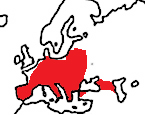|
Fat Dormouse
(Glis glis) #61-614 |
||||
|
|
Physical
characteristics and distribution
|
|
They are small for rodents, with a typical length of about 2-3" (70 mm). Fat Dormice typically feed on fruits, berries, flowers, nuts and insects. They are largely but not exclusively arboreal and nocturnal animals. One of the most notable characteristics of those dormice that live in temperate zones is hibernation. Fat Dormice can hibernate six months out of the year, or even longer if the weather remains sufficiently cool, sometimes waking for brief periods to eat food they had previously stored nearby. It is from this trait that they got their name, which comes from Anglo-Norman dormeus, which means "sleepy (one)"; the word was later altered by folk etymology to resemble word "mouse". They breed once or twice a year, with four being the typical size of a litter and can live for as long as five years. Fat Dormice are mostly found in Europe, but have been introduced into England (see details: Mammal Species of the World, 2005, Vol 2, p840). |
|
Description
of the brain
|
|
Animal
source and preparation
|
|
All
specimens collected followed the same preparation
and histological procedure.
|
Other Related Resources (websites and publications)



